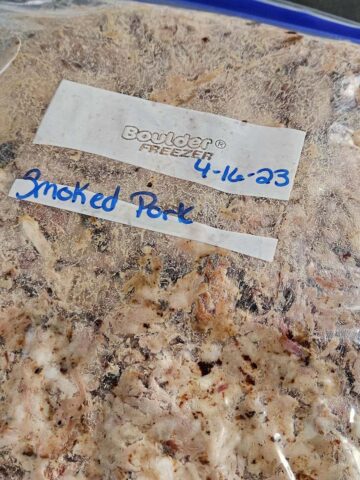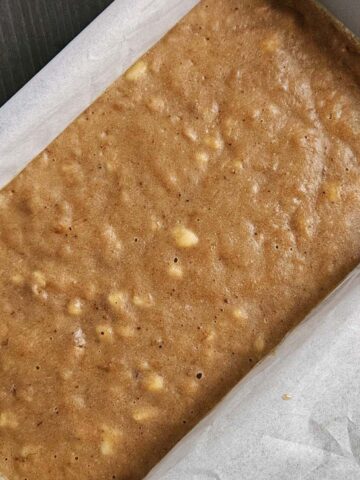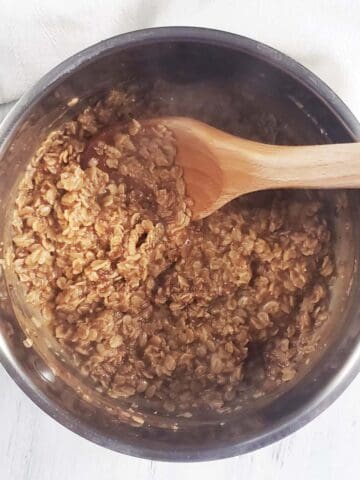Cooking with fresh herbs is a great way to finish a dish and add a burst of fresh flavor to every bite.
Learn how to cook with fresh herbs using this helpful guide to answer all of your fresh herb questions. You'll learn how to shop for fresh herbs and the best way to store them.

Jump to:
- Save This Recipe to Your Email
- Buying Fresh Herbs
- How to Store Fresh Herbs
- Herb Storage Chart
- Washing Fresh Herbs
- Freezing Fresh Herbs
- When Should You Add Fresh Herbs to a Dish?
- Is it Better to Use Fresh or Dried Herbs?
- How do You Convert Dry Herb Measurements to Fresh?
- How to Cook with Fresh Herbs
- More Tips
- 💬 Comments
Have you ever bought fresh herbs from the grocery store used a sprig or two and left the rest of the package languishing in the back of the refrigerator? Don't let these powerful flavors go to waste.
Are you intimidated by fresh herbs? Do you have an out-of-control herb garden?
Maybe you don’t know how to best store and handle them. Are you wondering what herbs go with what food and when should they be added to a dish? Keep reading for answers to all of these questions.
Buying Fresh Herbs
At your local grocery store, there are several different ways fresh herbs are sold: loose in small plastic boxes, fastened in bunches with rubber bands, mixed with olive oil in a plastic tube, or sometimes still growing in a pot.
Look for herbs with vibrant green color and fresh aroma. Go ahead and open up those plastic boxes for a sniff. I won't tell anyone. Avoid herbs that are limp, yellowing, have black spots, or don’t look and smell completely fresh.
For some of the freshest herbs consider stopping by your local farmers market.
How to Store Fresh Herbs
- Towel Method: Hardy herbs such as chives, dill, lemongrass, marjoram, oregano, sage, rosemary, and thyme should be wrapped in a damp paper towel, and placed in a zip-top bag, and stored in the refrigerator. Herbs will last up to two weeks using this storage method.
- Planting Method: Delicate herbs such as cilantro, parsley, mint, and tarragon should be stored using the “planting” method. Remove any rubber bands, trim the base of the stems with scissors or a knife, and remove any wilted leaves. Fill a glass jar with an inch of cold water. Place the herbs stem down into the water and cover the tops with a plastic bag. Secure the bag with a rubber band and place it in the refrigerator. Herbs will last up to three weeks using this storage method.
Basil is a rule breaker. Use the planting method to store basil, but leave it uncovered and at room temperature.
Herb Storage Chart
| Herb | Towel Method | Planting Method |
|---|---|---|
| Herb | Towel Method | Planting Method |
| Basil | X * | |
| Chives | X | |
| Cilantro | X | |
| Dill | X | |
| Lemongrass | X | |
| Marjoram | X | |
| Mint | X | |
| Oregano | X | |
| Parsley | X | |
| Rosemary | X | |
| Sage | X | |
| Tarragon | X | |
| Thyme | X |
*Basil is a rule breaker. Use the planting method, but leave basil uncovered and at room temperature.
Washing Fresh Herbs
Wash herbs just before you are ready to use them. Put them in a bowl of water and swish them around to loosen any dirt. Pat them dry them using a clean cloth or spin them in a salad spinner.
This is my favorite salad spinner! I have been using it several times a week for years and it still looks brand new. It even comes apart in several pieces to make cleaning easier.

Freezing Fresh Herbs
If you will not be able to use all of your herbs before they start to wilt, you can freeze them for later use.
- Wash, dry, and chop the herbs.
- Place the chopped herbs into ice cube trays.
- Add a small amount of olive oil to each cube. Some of the herbs will float to the top. That is ok we will take care of them tomorrow.
- Place the ice cube tray in your freezer and let it sit overnight. Once the herbs are frozen, remove them from the freezer and top off with more olive oil until the herbs are completely covered, and return them to the freezer.
- Once they are frozen, remove the cubes and place them in a plastic zip-top bag labeled with the date and contents.
For even more information about freezing herbs check out this post: Three Methods for Freezing Fresh Herbs

Tip: Use a sharp knife or these herb scissors to chop fresh herbs. A dull knife will crush instead of cut the herbs which will cause bruising.
When Should You Add Fresh Herbs to a Dish?
Hardier woodier herbs should be added at the beginning of cooking. Herbs like marjoram, thyme, and rosemary do best when they are allowed to mellow during the cooking process.
Lightly crush the sprig before adding it to release the flavor oils of an herb in a slow-cooking sauce, soup, or stew. Leaving the leaves on the stem makes it easy to remove the whole herb later.
For lighter more tender herbs chop them and add them near the end of cooking or sprinkled on top of a finished dish.
Don't waste the stems save them to add to your next batch of chicken stock.

Is it Better to Use Fresh or Dried Herbs?
I wouldn't say one is better than the other. But they excel at different tasks.
Dried herbs should be added early during the cooking process. They need time to infuse the dish with their flavor. Dried herbs are also great for rubs.
Fresh herbs have a more subtle flavor and are best used in dishes that have a shorter cooking time. If a dish takes longer to prepare, make sure you add the fresh herbs towards the end of cooking so that they maintain their flavor.
How do You Convert Dry Herb Measurements to Fresh?
If you are replacing dried herbs with fresh herbs in a recipe, use 3-4 times more fresh herbs than the recipe calls for and add them at the end of the cooking process.
For example if a recipe calls for 1 teaspoon of dried herbs you will want to use a tablespoon of fresh herbs.
How to Cook with Fresh Herbs

Fresh Basil
A close relative to mint, basil has a sweet peppery licorice flavor. There are two main types of basil: Sweet, or Genoese, basil, and Asian basils. Sweet basil pairs well with tomatoes and almost every type of meat or seafood. Asian basil has a stronger licorice flavor and is often used in soups, stews, stir-fries, and curry pastes.
Try adding it to curries, pestos, soups, stews, stir-fries, and tomato sauces. Add basil at the end of cooking for maximum flavor and to prevent browning.
How to Store Basil
Basil is a rule breaker. Use the planting method mentioned above to store basil, but leave it uncovered and at room temperature. To dry basil, use a dehydrator or spread the leaves out on a large baking sheet and heat at your oven's lowest temperature setting until dry and crumbly.
Basil Pairs Well With
- Chicken
- Beef
- Fish
- Tofu
- Eggplant
- Bell Peppers
- Tomatoes
- Zucchini
- Mozzarella
- Pasta Sauces
Basil Recipes
Homemade Lasagna - Tastes of Lizzy T
Crispy Bacon Pasta Salad with Fresh Herbs - How Sweet Eats
Roasted Cherry Tomato Sauce with Fresh Herbs - It's a Veg World After All

Fresh Chives
Chives have a mild onion flavor. Try adding them to dips, garnishes, omelets, potato salads, rice, risottos, sauces, and soups. They also make a delicious addition to these sourdough crackers.
Chives are best when they are used raw or added at the very end of cooking so as to not lose their delicate flavor and vibrant hue. Purple chive blossoms are more pungent than the stems and can be a beautiful addition to a salad.
How to Store Chives
Store chives using the paper towel method mentioned above. Chives will keep in the refrigerator for 10 days. To dry chives, use a dehydrator or spread the leaves out on a large baking sheet and heat at your oven's lowest temperature setting until dry and crumbly.
Chives Pair Well With
- Chicken
- Fish
- Shellfish
- Eggs
- Asparagus
- Cucumbers
- Onions
- Potatoes
Chives Recipes
Buttermilk Ranch Dressing - Food Folks and Fun
Mini Cream Cheese and Chive Biscuits - How Sweet Eats
Garlic and Chive Mashed Potatoes - Natasha's Kitchen

Fresh Cilantro
Cilantro has a bright citrusy flavor. Try adding it to chutneys, curries, guacamole, salads, salsas, and soups. Cilantro is best when added after a dish has been cooked. Some people do not like the flavor of cilantro (myself included I often use parsley instead) and think it tastes soapy.
How to Store Cilantro
Use the planting method mentioned above to store cilantro. Cilantro will keep in the refrigerator for 10 days. To dry cilantro, use a dehydrator or spread the leaves out on a large baking sheet and heat at your oven's lowest temperature setting until dry and crumbly.
Cilantro Pairs Well With
- Chicken
- Fish
- Lamb
- Tofu
- Avocado
- Bell Peppers
- Tomatoes
- Lentils
Cilantro Recipes
Mango Salsa - Tastes of Lizzy T
Thai Quinoa Salad with Fresh Herbs and Lime Vinaigrette - Once Upon a Chef
Cilantro Lime Rice - Spend with Pennies

Fresh Dill
Dill has a tangy grassy flavor. Try adding it to omelets, potato salad, salad dressings, sauces, and yogurt dishes. Dill is also popular in pickling recipes. Remember a little bit of dill will go a long way.
How to Store Dill
Store dill using the paper towel method mentioned above. Dill will keep in the refrigerator for 10 days. To dry dill, use a dehydrator or spread the leaves out on a large baking sheet and heat at your oven's lowest temperature setting until dry and crumbly.
Dill Pairs Well With
- Fish
- Shellfish
- Cabbage
- Carrots
- Cucumber
- Green Beans
- Lemon
- Potatoes
- Tomatoes
- Yogurt
Dill Recipes
Dill Pickle Dip - Dinner at the Zoo
Cheddar and Dill Pickle Pasta Salad - Yellow Bliss Road
Dill and Maple Roasted Carrots - It's a Veg World After All

Fresh Lemongrass
Lemongrass has a zesty citrusy flavor. Try adding it to Asian soups, curries, marinades, rice, and tea. When purchasing lemongrass, look for firm, pale-green stalks with bulbous bottoms and fresh-looking tops. Most of the lemongrass's flavor is found in the bottom four inches. Its flavor becomes more intense as it is cooked.
How to Store Lemongrass
Store lemongrass using the paper towel method mentioned above. Lemongrass will keep in the refrigerator for several weeks.
Lemongrass Pairs Well With
- Beef
- Chicken
- Fish
- Pork
- Tomatoes
- Bell Peppers
Lemongrass Recipes
Lemongrass Chicken with Cashews and Edamame - Foolproof Living
Crispy Pan-Fried Lemongrass Chicken - I am a Food Blog

Fresh Marjoram
Marjoram has a sweet grassy flavor. Try adding it to brown butter sauce, risottos, salad dressings, soups, and stuffing. Fresh marjoram is less flavorful than the dried version. For the most flavor add marjoram at the end of cooking.
How to Store Marjoram
Store marjoram using the paper towel method mentioned above. Marjoram will keep in the refrigerator for 10 days. To dry marjoram, use a dehydrator or spread the leaves out on a large baking sheet and heat at your oven's lowest temperature setting until dry and crumbly.
Marjoram Pairs Well With
- Beef
- Chicken
- Carrots
- Mushrooms
- Peas
- Spinach
- Tomatoes
- Zucchini
Marjoram Recipes
Crock-pot Lasagna Soup - Crock-pot Ladies
Quick Italian Bean Soup - Confessions of an Overworked Mom
Roasted Lemon Garlic Herb Chicken - Cooking Classy

Fresh Mint
Mint has a sweet cool flavor. Try adding it to cocktails, cream sauces, curries, fruit salads, lemonade, marinades, and soups. Mint adds a nice cooling flavor to spicy dishes. Spearmint has a sweeter flavor while peppermint has a much stronger flavor.
How to Store Mint
Use the planting method mentioned above to store mint. Mint will keep in the refrigerator for 10 days. To dry mint, use a dehydrator or spread the leaves out on a large baking sheet and heat at your oven's lowest temperature setting until dry and crumbly.
Mint Pairs Well With
- Lamb
- Carrots
- Eggplant
- Fruit
- Mushrooms
- Potatoes
- Tomatoes
- Zucchini
- Watermelon
- Beans
- Lentils
Mint Recipes
Fresh Mint Chocolate Chip Cookies
Fresh Mint Brownies
Spring Shrimp Zucchini Noodles with Mint Pesto - Lively Table
Cool Smashed Cucumber and Minted Peas - Fuss Free Flavours

Fresh Oregano
Oregano has a peppery bitter flavor. Try adding it to pizzas, tomato sauces, and salad dressings. Oregano also makes a delicious addition to these sourdough flatbreads. Fresh oregano has a stronger flavor than its dried counterpart. Because of its strong flavor oregano can be added at the beginning of cooking.
How to Store Oregano
Store oregano using the paper towel method mentioned above. Oregano will keep in the refrigerator for 10 days. To dry oregano, use a dehydrator or spread the leaves out on a large baking sheet and heat at your oven's lowest temperature setting until dry and crumbly.
Oregano Pairs Well With
- Beef
- Chicken
- Lamb
- Fish
- Artichokes
- Bell Peppers
- Eggplant
- Mushrooms
- Potatoes
- Tomatoes
- Zucchini
Oregano Recipes
Crock-pot Creamy Italian Sausage Soup with Pasta - Crock-pot Ladies
Tomato Salad with Cucumber Dressing - The Honeycomb Home
Crockpot Baked Beans - My Recipe Confessions
Homemade Vegetable Loaded Spaghetti Sauce - Raspberries & Kohlrabi

Fresh Parsley
Parsley has a fresh grassy flavor. Parsely is one of the most common and versatile herbs. It seems like every savory recipe I read calls for a bit of parsley. Try adding it to garnishes, salsas, and sauces.
Parsely has a subtle flavor and you can use both the leaves and the stems. Flat-leaf or Italian parsley has the best texture and flavor for cooking. Curly parsley is best used only as a garnish. Raw parsley also acts as a natural breath freshener.
How to Store Parsley
Use the planting method mentioned above to store parsley. Parsley will keep it in the refrigerator for 10 days. To dry parsley, use a dehydrator or spread the leaves out on a large baking sheet and heat at your oven's lowest temperature setting until dry and crumbly.
Parsley Pairs Well With
- Beef
- Chicken
- Fish
- Lamb
- Tofu
- Eggs
- Butter
- Cucumbers
- Lemon
- Mushrooms
- Peas
- Potatoes
- Tomatoes
- Zucchini
- Pasta
Parsley Recipes
Homemade Meatballs - Raspberries and Kohlrabi
Mediterranean Potato Salad - Amanda's Cookin'
Cheeseburger Bites Crescent Roll Appetizers - The Honeycomb Home

Fresh Rosemary
Rosemary has a piney pungent flavor. Try adding it to focaccia bread, pizzas, roasted vegetables, sauces, soups, stews, and tomato sauces. If you are not using whole springs, chop rosemary finely. Its needle-like leaves can remain tough even after being cooked for a long time. Rosemary's flavor can be quite strong so use it sparingly.
How to Store Rosemary
Store rosemary using the paper towel method mentioned above. Rosemary will keep in the refrigerator for 10 days. To dry rosemary, use a dehydrator or spread the leaves out on a large baking sheet and heat at your oven's lowest temperature setting until dry and crumbly.
Rosemary Pairs Well With
- Chicken
- Fish
- Lamb
- Pork
- Rabbit
- Mushrooms
- Peas
- Potatoes
- Tomatoes
Rosemary Recipes
Garlic Herb-Crusted Roast Beef - Tastes of Lizzy T
Lemon Garlic Herb-Grilled Salmon - Cooking Classy
Crispy Baked Goat Cheese over Roasted Rosemary Squash and Garlicky Fettuccine - The Foodie and the Fix

Fresh Sage
Sage has a bitter musty flavor. Try adding it to brown butter sauce, risottos, roasted vegetables, salad dressing, soups, and stuffing. Sage has a strong flavor so use it sparingly to avoid overpowering your dish. When buying sage look for leaves that are brightly colored and not wilted.
How to Store Sage
Store sage using the paper towel method mentioned above. Sage will keep in the refrigerator for 10 days. To dry sage, use a dehydrator or spread the leaves out on a large baking sheet and heat at your oven's lowest temperature setting until dry and crumbly.
Sage Paris Well With
- Beef
- Chicken
- Pork
- Turkey
- Brussel Sprouts
- Eggplant
- Peas
- Winter Squash
Sage Recipes
Crock-pot Pumpkin Risotto - Crock-pot Ladies
Sage Butter Biscuits - How Sweet Eats
Creamy Pumpkin Pasta with Sausage and Sage - Food Folks and Fun

Fresh Tarragon
Tarragon has a sweet licorice flavor. Try adding it to garnishes, gazpachos, omelets, and salad dressings. To make the most of its unique flavor, add tarragon near the end of cooking.
How to Store Tarragon
Use the planting method mentioned above to store tarragon. Tarragon will keep in the refrigerator for 10 days. It is not recommended to dry tarragon as it loses much of its flavor.
Tarragon Pairs Well With
- Beef
- Chicken
- Lamb
- Fish
- Artichokes
- Carrots
- Leeks
- Mushrooms
- Potatoes
- Spinach
Tarragon Recipes
Eggplant and Goat Cheese Sandwiches with Tomato Tarragon Sauce - Domestic Superhero
Sheet Pan Salmon Dinner - Amanda's Cookin'
Asiago Parmesan Cheese Spread - My Pinterventures

Fresh Thyme
Thyme has a floral minty flavor. Try adding it to dips, rice, roasted vegetables, stews, and tomato sauces. Thyme should be added early in the cooking process to give it time to release its flavor.
How to Store Thyme
Store thyme using the paper towel method mentioned above. Thyme will keep in the refrigerator for 10 days. To dry thyme, use a dehydrator or spread the leaves out on a large baking sheet and heat at your oven's lowest temperature setting until dry and crumbly.
Thyme Pairs Well With
- Beef
- Chicken
- Duck
- Lamb
- Turkey
- Fish
- Eggs
- Bread,
- Carrots
- Peas
- Potatoes
- Tomatoes
- Winter Squash
Thyme Recipes
Ham and Leek Pot Pie - Raspberries and Kohlrabi
Leek and Potato Soup - Raspberries and Kohlrabi
Roasted Carrots with Thyme - Once Upon a Chef
Crock-Pot Acorn Squash Soup - Crock-Pot Ladies
Sourdough Blueberry Thyme Scones - Raspberries and Kohlrabi
More Tips
Thanks for Reading!
If you try this recipe, let me know! Leave a comment and rate it below! You can also snap a picture and post it on Facebook or Instagram be sure to tag me @RaspberriesandKohlrabi.
Subscribe to get more recipes and tips by email.







Comments
No Comments